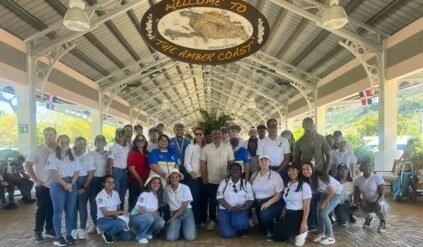As part of the strategic alliance agreed between the Puerto Plata Destination Tourism Cluster (CTDPP) and the School of Tourism and Gastronomy of the Pontificia Universidad Católica Madre y Maestra (PUCMM), students and professors of the university visited the ports of Amber Cove and Taino Bay, to apply surveys that will reflect the impact generated by the cruise industry in the value chain and the local economy.
The field practice is part of a series of investigations to structure a market intelligence system that systematically, objectively, and transparently collects and examines data and statistics to plan strategically for tourism-related projects in the province.
Students from Santo Domingo and Santiago, accompanied by professors from both centers, participated in the application of questionnaires in both terminals to capture data on the demographics of visitors, both passengers and crew, their activity, levels of spending, and satisfaction at the destination, willingness to return, among others. Interviews will soon be conducted to investigate the effects of this operation on employment.
The institutions involved in the project announced that all this information would form a baseline study of the socioeconomic impact of cruise ships in the province of Puerto Plata, the results of which will be published later. Furthermore, they added that the cruise ship department of the Ministry of Tourism (Mitur) would continue to use the tool for a constant compilation of data to obtain a realistic and updated picture.
PUCMM was represented by Ina Percival, director of the School of Gastronomy and Tourism of the Saint Thomas Aquinas Campus, and professors Clara Barriola, Mirian Laureano, Jetti de Jesús, and Soraya Sànchez.
Also present were Birgitt Heinsen, president of the CTDPP; Atahualpa Paulino, regional director of Mitur; Zobeyda Brito, for the Cruise Department of Mitur; port managers Sharon Mei of Amber Cove, and Harold Sanders of Taino Bay.

